
The Hygrophoraceae are a family of fungi in the order Agaricales. Originally conceived as containing white-spored, thick-gilled agarics, including Hygrophorus and Hygrocybe species, DNA evidence has extended the limits of the family, so it now contains not only agarics, but also basidiolichens and corticioid fungi. Species are thus diverse and are variously ectomycorrhizal, lichenized, associated with mosses, or saprotrophic. The family contains 34 genera and over 1000 species. None is of any great economic importance, though fruit bodies of some Hygrocybe and Hygrophorus species are considered edible and may be collected for sale in local markets.

Hygrophorus is a genus of agarics in the family Hygrophoraceae. Called "woodwaxes" in the UK or "waxy caps" in North America, basidiocarps are typically fleshy, often with slimy caps and lamellae that are broadly attached to decurrent. All species are ground-dwelling and ectomycorrhizal and are typically found in woodland. Around 100 species are recognized worldwide. Fruit bodies of several species are considered edible and are sometimes offered for sale in local markets.

Hygrocybe is a genus of agarics in the family Hygrophoraceae. Called waxcaps in English, basidiocarps are often brightly coloured and have dry to waxy caps, white spores, and smooth, ringless stems. In Europe they are characteristic of old, unimproved grasslands which are a declining habitat, making many Hygrocybe species of conservation concern. Four of these waxcap-grassland species, Hygrocybe citrinovirens, H. punicea, H. spadicea, and H. splendidissima, are assessed as globally "vulnerable" on the IUCN Red List of Threatened Species. Elsewhere waxcaps are more typically found in woodlands. Most are ground-dwelling and all are believed to be biotrophs. Around 150 species are recognized worldwide. Fruit bodies of several Hygrocybe species are considered edible and are sometimes offered for sale in local markets.
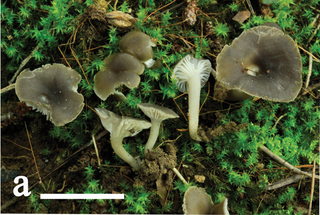
Camarophyllopsis is a genus of agarics in the family Clavariaceae. Basidiocarps are dull-coloured and have dry caps, rather distant, decurrent lamellae, white spores, and smooth, ringless stems. In Europe species are characteristic of old, unimproved grasslands which are a declining habitat, making them of conservation concern.
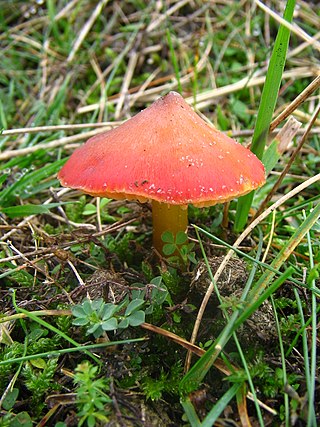
Hygrocybe conica is a species of agaric in the family Hygrophoraceae. In the UK it has been given the recommended English name of blackening waxcap, since all parts of the basidiocarp blacken with age. In North America it is commonly known as the witch's hat, conical wax cap or conical slimy cap. Hygrocybe conica is known to be a complex of at least eleven closely related species and as such is widespread in Europe, North America, Asia, and elsewhere.

The Tricholomataceae are a large family of fungi within the order Agaricales. Originally a classic "wastebasket taxon", the family included any white-, yellow-, or pink-spored genera in the Agaricales not already classified as belonging to e.g. the Amanitaceae, Lepiotaceae, Hygrophoraceae, Pluteaceae, or Entolomataceae.

Cuphophyllus is a genus of agaric fungi in the family Hygrophoraceae. Cuphophyllus species belong to a group known as waxcaps in English, sometimes also waxy caps in North America or waxgills in New Zealand. In Europe, Cuphophyllus species are typical of waxcap grasslands, a declining habitat due to changing agricultural practices. As a result, four species, Cuphophyllus atlanticus, C. colemannianus, C. lacmus, and C. lepidopus are of global conservation concern and are listed as "vulnerable" on the IUCN Red List of Threatened Species.
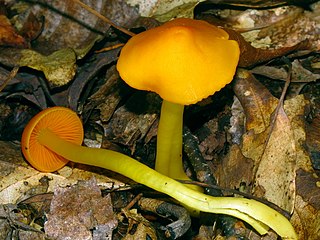
Humidicutis is a small genus of brightly coloured agarics, the majority of which are found in Eastern Australia. They were previously described as members of Hygrocybe. The genus Porpolomopsis is closely related, and the species in it were once placed in Humidicutis. The genus was described by mycologist Rolf Singer in 1959.
Acantholichen is a fungal genus in the family Hygrophoraceae. The genus was circumscribed by Norwegian lichenologist Per Magnus Jørgensen to contain the type, and at that time, only species, the basidiolichen Acantholichen pannarioides, discovered originally in Costa Rica in 1998. This species has a bluish, gelatinous thallus, and a fine, white powdery bloom covering the hairy upper surface; this surface is said to resemble "an unshaven chin". Five additional species, all basidiolichens, were added to the genus in 2016 following an in-depth analysis of specimens collected from the Galápagos, Costa Rica, Brazil and Colombia.
Haasiella is a fungal genus in the family Hygrophoraceae. It is a monotypic genus that contains only the species Haasiella splendidissima. Haasiella venustissima, formerly considered to be a distinct species based on its one and two-spored basidia, was found by a DNA study to be synonymous with H. splendidissima. H. splendidissima is only known from Europe and is saprotrophic on wood. Haasiella was described as a new genus in 1966 by Czech mycologists František Kotlaba and Zdeněk Pouzar. It is most closely related to the genus Hygrophorus.
Hygroaster is a genus of mushroom-forming fungi in the family Hygrophoraceae. The genus was described by mycologist Rolf Singer in 1955.

Pseudoarmillariella is a genus of fungi in the family Hygrophoraceae. The genus contains three species found in Central America, North America, and Asia. Pseudoarmillariella was described by mycologist Rolf Singer in 1956.
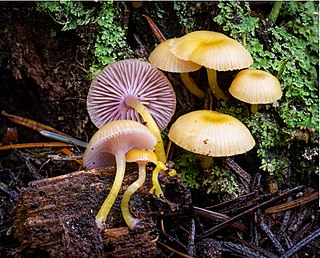
Chromosera is a genus of fungi in the family Hygrophoraceae. Within the family Hygrophoraceae it is closely related to the genus Gloioxanthomyces. It contains five species. The generic name honors the mycologist Meinhard Moser, and also alludes (chromos) to the distinct coloration of the mushrooms, by overlapping 'chromos' with 'Moser', hence Chromosera.
Semiomphalina is a basidiolichen genus in the family Hygrophoraceae. The genus is monotypic, containing the single species Semiomphalina leptoglossoides, found in Papua New Guinea.
Dictyonema is a genus of mainly tropical basidiolichens in the family Hygrophoraceae.
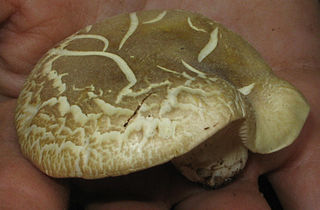
Cantharocybe is a genus of mushroom-forming fungi in the family Hygrophoraceae. The genus was described by American mycologists Howard E. Bigelow and Alexander H. Smith in 1973. Cantharocybe contains three species: the type C. gruberi, and C. brunneovelutina from Belize, reported as new to science in 2011, and C. virosa, transferred from "Megacollybia", and found in Bangladesh and India.
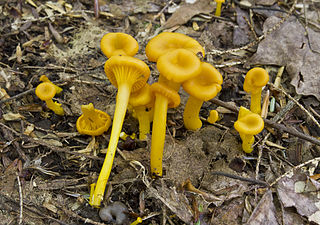
Gloioxanthomyces is a genus of fungi in the family Hygrophoraceae. It was circumscribed in 2013 to contain G. nitidus, and the type species, G. vitellinus. Within the Hygrophoraceae, it is in the tribe Chromosereae and closely related to the genus Chromosera. The generic name derives from the Greek gloio ("glutinous"), xantho ("yellow"), and myces (fungus).
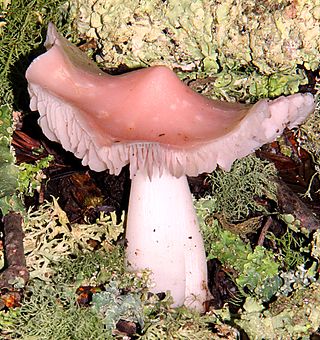
Porpolomopsis is a genus of fungi in the family Hygrophoraceae. It was circumscribed in 2008 by Andreas Bresinsky to contain P. calyptriformis. Bresinsky separated it from the genus Hygrocybe based on its color and the absence of DOPA pigments. P. lewelliniae was transferred to the genus based on DNA and morphology. Three undescribed species also belong in the genus. Species of Porpolomopsis have also formerly been placed in the genus Humidicutis, to which they are closely related but differ in having narrowly attached or free gills and the shape of the hyphae in their cap. Species of Porpolomopsis are found in Europe, North America, Asia, Australia and New Zealand.












